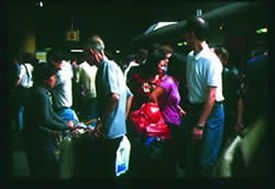 Wong Kayu
Wong Kayu
24-hour operationNo simple solutions
By Alice Tong
Arising number of commuters between Lo Wu and
Shenzhen, combined with congestion at the border
crossing, has resulted in a suggestion for 24-hour
operations at border checkpoints. However, the
government has not approved the idea.
The proposal raises complicated technical and
social issues.
Difficulties begin with the present transport system’s
inability to support a non-stop passenger flow.
Ms. Freda Man of the Kowloon Canton Railway said, “It takes our staff four to five hours a day for the maintenance and clean-up of the railroad tracks. In addition, trains running at midnight cause noise in residential neighborhoods.”
Moreover, the government says that there are few commuters after midnight.
Prof. Zhang Li of the Department of Geography and Resource Management at The Chinese University of Hong Kong agrees.
“At midnight the number of travellers apparently drops,” said he.
“Revenue (from 24-hour operations) may not cover the costs. Additional resources in both the KCR and the Immigration Department would be a waste.”
Mr. Wong Sing Chi, a Northern District Councilor, is concerned about the social consequences of a 24-hour operation.
He said that without restrictions on crossing the border, teenagers may seek entertainment in Shenzhen without telling their parents. And the number of extramarital affairs may also rise.
More importantly, Mr. Wong and Prof. Zhang said that a 24-hour operation would not be a practical way to tackle the congestion problem at the Lo Wu border crossing.
The KCR and the Immigration Department have done a lot to relieve the congestion by rearranging the immigration counters at the departure hall in Lo Wu to make more space.
When the departure hall becomes too crowded, the frequency of trains is reduced to prevent people from rushing to Lo Wu. Some trains even terminate in Sheung Shui to avoid overcrowding in Lo Wu.
If there are more than 2,000 people at the platform at Lo Wu, the KCR contacts the Immigration Department in urgent consultations to cope with the situation.
Apart from dealing with the needs during peak hours, the Immigration Department has measures to meet the increased demand in future.
It will broaden the Lo Wu Bridge, increasing traveller flow from about 20,000 per hour to at maximum 45,500. It will also add 117 more staff members in Lo Wu in the near future.
The department also hopes that the introduction of multi-purpose electronic identity cards will shorten the arrival and departure procedures.
Though 24-hour operation is not a solution to the congestion problem in Lo Wu, it is believed that it will come to be nevertheless. It is just a matter of time.
Mr. Wong of the Northern District Council put it this way: “Hong Kong is a part of China. A border seems to be unnecessary.”